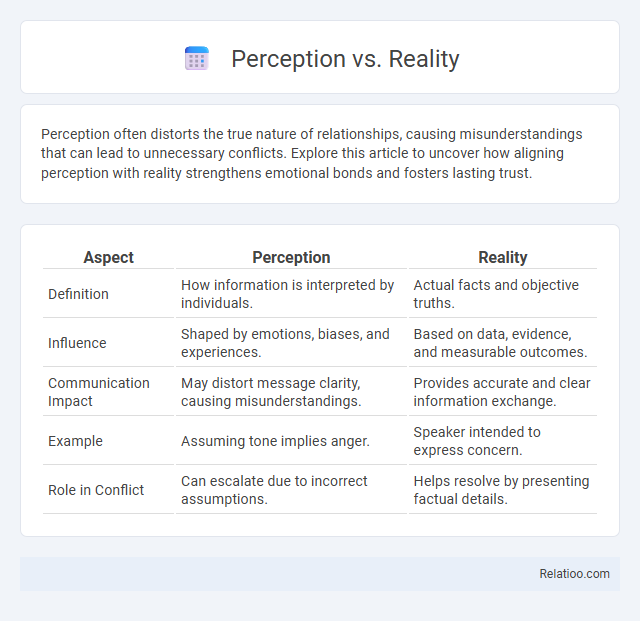Perception often distorts the true nature of relationships, causing misunderstandings that can lead to unnecessary conflicts. Explore this article to uncover how aligning perception with reality strengthens emotional bonds and fosters lasting trust.
Table of Comparison
| Aspect | Perception | Reality |
|---|---|---|
| Definition | How information is interpreted by individuals. | Actual facts and objective truths. |
| Influence | Shaped by emotions, biases, and experiences. | Based on data, evidence, and measurable outcomes. |
| Communication Impact | May distort message clarity, causing misunderstandings. | Provides accurate and clear information exchange. |
| Example | Assuming tone implies anger. | Speaker intended to express concern. |
| Role in Conflict | Can escalate due to incorrect assumptions. | Helps resolve by presenting factual details. |
Understanding Perception and Reality
Understanding perception involves recognizing how your senses and cognitive biases shape the way you interpret the world, often causing a divergence from objective reality. Reality consists of facts and events that exist independently of your interpretation or beliefs. Bridging the gap between perception and reality requires critical thinking and self-awareness to align your understanding with factual information.
The Psychology Behind Perception
Perception is the process by which your brain interprets sensory information to create an understanding of reality, but this interpretation can be influenced by biases, past experiences, and expectations, leading to discrepancies between actual reality and perceived reality. The psychology behind perception explores how cognitive processes like attention, memory, and emotion shape your subjective experience, often causing illusions or misinterpretations. Understanding these psychological mechanisms helps you recognize the differences between what is real and what your mind constructs, improving critical thinking and decision-making.
How Reality Differs from Our Perceptions
Your perception often filters reality through personal biases, emotions, and limited information, causing a significant divergence between what is real and what you believe to be true. Reality exists independently of your perceptions, grounded in objective facts and external truths that remain constant despite subjective interpretations. Understanding this distinction is crucial for developing clearer judgment and making decisions based on actual circumstances rather than distorted impressions.
Cognitive Biases That Shape Our Views
Cognitive biases such as confirmation bias, anchoring, and the availability heuristic significantly distort perception, causing individuals to interpret reality through subjective filters rather than objective facts. These biases reinforce pre-existing beliefs, leading to a divergence between perceived reality and actual circumstances. Understanding the impact of cognitive biases is essential for improving decision-making accuracy and aligning perceptions closer to true reality.
Perception in Personal Relationships
Perception in personal relationships shapes how you interpret emotions, intentions, and behaviors, often influencing trust and communication. Misaligned perceptions can lead to misunderstandings, creating conflicts despite the underlying reality. Enhancing self-awareness and empathetic listening helps bridge the gap between perception and reality, fostering healthier connections.
Media’s Role in Distorting Reality
Media plays a crucial role in shaping your perception by selectively presenting information that can distort reality, often emphasizing sensationalism or bias. The blurred line between perception and reality becomes evident as media narratives influence public opinion, sometimes leading to misconceptions or skewed worldviews. Understanding this dynamic helps you critically evaluate news sources and discern the factual basis behind mediated content.
Perception vs Reality in Decision-Making
Perception vs reality in decision-making often leads to biased outcomes when individuals rely on subjective interpretations rather than objective facts. Cognitive biases such as confirmation bias and availability heuristic distort perception, causing decisions that do not align with actual data or situational truths. Enhancing decision-making accuracy requires integrating evidence-based analysis with awareness of perceptual limitations to bridge the gap between perceived and real conditions.
Bridging the Gap: Aligning Perception and Reality
Bridging the gap between perception and reality requires a deep understanding of cognitive biases and effective communication strategies. Your ability to align these two dimensions enhances decision-making accuracy and fosters trust in both personal and professional relationships. Tools like feedback loops and data-driven insights play a crucial role in reconciling differences and promoting clarity.
Common Misconceptions in Modern Society
Common misconceptions in modern society arise when perception is mistaken for reality, leading to widespread false beliefs and biased judgments. Social media amplifies distorted perceptions by promoting curated content that often does not reflect objective truths. Understanding the divergence between perception and reality is crucial for fostering critical thinking and reducing misinformation.
Strategies for Seeing Reality More Clearly
Developing strategies to see reality more clearly involves recognizing cognitive biases such as confirmation bias and selective perception that distort our views. Engaging in active listening, seeking diverse perspectives, and employing critical thinking techniques help differentiate between subjective perception and objective reality. Regular reflection and evidence-based analysis enhance the accuracy of understanding, allowing for better decision-making grounded in factual information.

Infographic: Perception vs Reality
 relatioo.com
relatioo.com